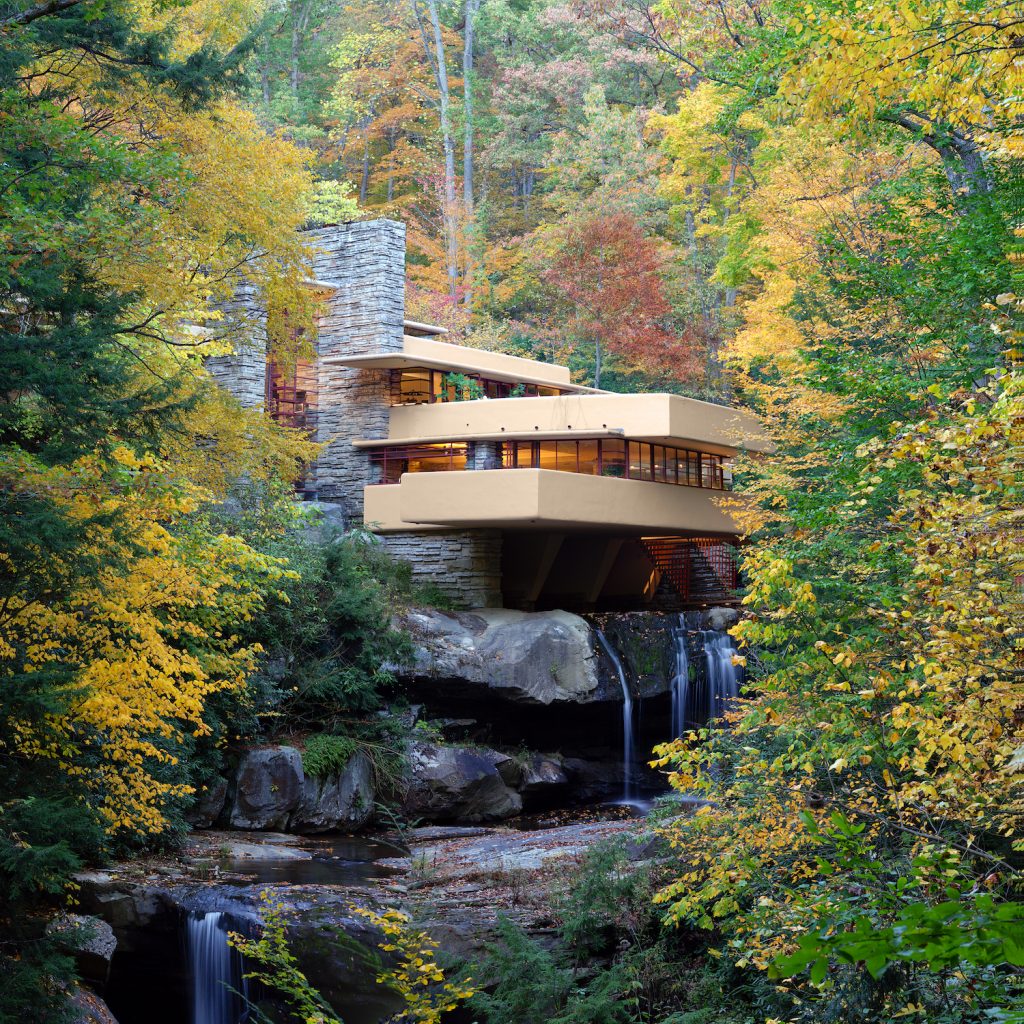
This design style was quite the contrast to the architectural movements of the time, such as modernism, although there are a few modernist characteristics in his work. The circulation through the house consists of dark, narrow passageways, intended this way so that people experience a feeling of compression when compared to that of expansion the closer they get to the outdoors. Wright's admiration for Japanese architecture was important in his inspiration for this house, along with most of his work.
more recommended books, videos, and DVDs
The integration of water, trees, rocks, sky and nature throughout the house closes off a certain romantic vision of the house, but opens up a new spatial-temporal dimension for man’s refuge. Edgar J. Kaufmann, Sr., a department store magnate, and his wife, Liliane, commissioned Wright to design a weekend retreat on the family’s land near the former Bear Run community southeast of Pittsburgh. Kaufmann had been introduced to Wright by his son, Edgar, in 1934, when the latter participated in Wright’s Taliesin Fellowship, a training program for architects and artists. Wright was 67 at the time of the meeting, with few commissions in the midst of the Great Depression.
I Went to Frank Lloyd Wright's Iconic 'Fallingwater' House in Pennsylvania — Here's What It's Like to Visit - Travel + Leisure
I Went to Frank Lloyd Wright's Iconic 'Fallingwater' House in Pennsylvania — Here's What It's Like to Visit.
Posted: Sat, 12 Nov 2022 08:00:00 GMT [source]
Corner windows

After completing the 9,300-square-foot main house (4,400 square feet of which are the outdoor terraces), Wright designed an additional 4,990-square-foot guest house. The latter was built in 1939, with 1,950 square feet of its own terraces. The living room flagstone floor blocks were individually tagged and removed.
Famous Fountains in Rome – The Most Famous Fountains in Italy
The shadows cast by the pergolas resemble those of the tree trunks; an effect which makes the shadow of the house fade into those of the trees. On the ground of the terrace outside Mr. Kaufmann’s office, two holes were intended to be left so that the trees could pass through them. However, as the trees died during the construction of the house, no such apertures were made.
Just like in Japanese architecture, Wright wanted to create harmony between man and nature, and his integration of the house with the waterfall was successful in doing so. This building, constructed over three levels, sits on a rock over a natural waterfall. Wright designed these windows--which when opened offered no structural support, as a way of bringing the natural sound of the stream into the house. This room featured an example of another of Wright's signature designs, the folded ceiling.
Experience Fallingwater
The clients, Pittsburgh department store magnate Edgar J. Kaufmann and his family, agreed. Their desire to be close to nature in this isolated weekend abode drove the design choices. Aside from the incredible beauty of its natural site, what makes Frank Lloyd Wright’s Fallingwater an architectural icon worthy of being designated a National Historic Landmark in 1976 and a UNESCO World Heritage Site in 2019?
This sculpture, which is near the main entrance to the house, is by Jacques Lipchitz. The famous Fallingwater waterfall, seen here as it emerges from underneath the house. These small shelves showcase Wright's design flair, as well as his dedication to having shelves and tables cantilever out from the stone walls. The walls are made from Pottsville sandstone, and the floors are polished with liquid Johnson Wax.
Sharing Our History
As a result, the cantilevered front of the house started to drop as soon as the concrete was removed. In 2019, Fallingwater, along with seven other buildings by Frank Lloyd Wright, was elected a UNESCO World Heritage Site. The terraces form a complex, overriding horizontal force with their protrusions that liberated space with their risen planes parallel to the ground. In order to support them, Wright worked with engineers Mendel Glickman and William Wesley Peters. Even as political battles over abortion consume Arizona’s Capitol, Democrats have seized on water as a life-or-death election issue that they hope gives them an opening — however slight — to reach out to rural voters who abandoned the party. Giant farms have turned Arizona’s remote deserts about 100 miles west of Phoenix as green as fairways — the product of extracting an ocean of groundwater to grow alfalfa for dairy cows.
The importance of the fireplace was emphasized by exposing a large part of the natural rock through the wall of the fireplace, literally bringing the waterfall into the house. From before Fallingwater was designed to when it was opened to the public for tours, there is a deep and rich history of the people, design, construction and relevance of Fallingwater. The design of the house is a clear example of naturalist architecture, as all the decisions taken in its construction were alongside the integration of the building with the countryside. It was intended that the work be converted into another natural element of the surroundings, in full harmony with it and with the passing of time.
Department of the Interior designated the museum a National Historic Landmark. In 2019, UNESCO added Fallingwater (and seven other Frank Lloyd Wright-designed sites) to its list of World Heritage Sites, marking an impressive international recognition of its architectural legacy. Now a museum, the site welcomes eager architectural fans from all over the world. Featuring a range of tours tailored to visitors' interests, exploring Fallingwater firsthand is an ideal way to appreciate this great blessing. This idea of bringing the outdoors inside is also evident in the home's collection of freestanding and built-in furniture. Fallingwater houses 170 decorative art pieces designed by Wright that channel the outdoors through both look and feel.
The Conservancy owns and operates the Fallingwater house, which is open to the public to view as a museum. The Bear Run Nature Reserve, which encompasses 5,100 acres of natural land, streams, and trails, surrounds Fallingwater. The Kaufmanns used sculpture, paintings, textiles, and furniture throughout Fallingwater to reflect their tastes in fine and decorative arts. But Wright made sure to include furniture designs of his own throughout the house.
The incredible house stayed in the family until after the father, Edgar Sr., and his wife Lilliane had both passed away. In 1963, son Edgar Jr. entrusted the house to the Western Pennsylvania Conservancy, and in 1965 it became a museum. And Liliane S. Kaufmann.’ Fallingwater first opened its doors in 1964 for public tours. Fallingwater visitors may be included in photography or videography during their time on site. Visitors grant the right for their images to be used in promotional materials and in all formats of media. All images shall be the property of the Western Pennsylvania Conservancy.
Blocks were joined to the concrete cantilever beams and floor joists; high-strength steel cables were fed through the blocks and exterior concrete walls and tightened using jacks. The floors and walls were then restored, leaving Fallingwater's interior and exterior appearance unchanged. As of 2011[update], the cantilevers have sufficient support and the deflection has stopped.[43] The Conservancy continues to monitor movement in the cantilevers. Fallingwater is a house designed by the architect Frank Lloyd Wright in 1935.


No comments:
Post a Comment